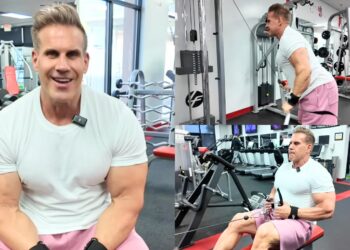Sit-ups are arguably one of the most well-known abs exercises. As a veteran personal trainer with over 30 years of experience, sit-ups were one of the very first abs moves I ever learned.
Now, more than three decades later, I hardly ever prescribe sit-ups to my clients. That’s because research strongly suggests that sit-ups are not a very effective exercise.
For starters, sit-ups involve more hip flexion than spine flexion, and it’s spine flexion that works the abs (1). Also, sit-ups put a lot of stress on the iliopsoas muscles, better known as the hip flexors. These muscles pull on your lumbar spine, creating a lot of vertebral shearing force. As a result, sit-ups can cause back pain and injury (2).
Despite this, sit-ups are still a popular exercise and some people can do them without a problem. However, in my opinion, the risk outweighs the benefits, so I mostly avoid them.
The good news is that there are lots of exercises you can do that are safer and more effective than sit-ups. In fact, I think there are probably more exercises for your abs than almost any other muscle group. After all, core training is VERY popular.
In this article, I share a five-move, 10-minute workout to strengthen your abs and enhance posture without sit-ups.
Level Up Your Fitness: Join our 💪 strong community in Fitness Volt Newsletter. Get daily inspiration, expert-backed workouts, nutrition tips, the latest in strength sports, and the support you need to reach your goals. Subscribe for free!
5-Move Abs Workout for Core Strength and Better Posture
Bored of doing endless sets of ineffective sit-ups? Or maybe you find them uncomfortable? Don’t worry – I’ve got you covered. This tried-and-tested workout includes some of the most functional core exercises I know to strengthen your abs and improve your posture. Do it 2-4 times a week to sculpt the midsection of your dreams.
But, before you start, make sure you prepare your muscles and joints with a warm-up. Begin with 5-10 minutes of easy cardio, followed by dynamic mobility and flexibility exercises that target your lower back, hips, and waist.
Alternatively, you can use this workout as a finisher after your main workout, when you won’t need any additional warming up.
Ready to go? Then let’s do it!
Perform the following exercises as a circuit. Do exercise number one, and then move quickly to number two. Continue down the list to the end, rest for one minute, and repeat once more. The entire two-lap sequence should take no more than ten minutes.
| Exercise | Sets | Reps* | |
| 1 | Dead Bug with Dumbbell | 2 | 8-15 |
| 2 | Alternating Side Plank | 2 | 8-15 |
| 3 | Stability Ball Back Extension | 2 | 12-20 |
| 4 | Slow Mountain Climber | 2 | 8-15 |
| 5 | Walkouts | 2 | 6-10 |
*Beginners should use the low end of the suggested repetition range while more experienced exercisers should aim for the high end. Intermediate exercises can split the difference and use the middle of the recommended range.
Exercise Instructions
As I often tell my clients, there are two ways to do any exercise – the right way and the wrong way. The right way is safe and effective because it puts the stress of the movement on the muscles you want to work. In contrast, the wrong way puts that stress on nearby muscles and joints. This not only wastes your energy but increases the risk of injury.
So, with that in mind, make sure you follow these step-by-step instructions and stop your set if you feel your form starting to deteriorate.
1. Dead Bug with Dumbbell
The dead bug is one of my favorite functional core exercises. It teaches you how to use your core to stabilize your spine while moving your arms and legs. This is how your core often has to function during everyday life. Adding a weight makes what is sometimes considered a beginner exercise much more challenging.
Steps:
- Lie on your back with your legs bent and knees above your hips.
- Brace your abs and press your lower back into the floor – a posterior pelvic tilt.
- Hold a dumbbell over your chest in two hands.
- Keeping your lower back pressed into the floor, extend one leg and lower the weight back and behind your head.
- Return to the starting position and repeat with the other leg.
- Continue alternating legs for the required number of reps.
2. Alternating Side Plank
Side planks emphasize your obliques, which are essentially your waist muscles. However, I’ve always found them a little boring because they’re so static. This alternating version is much more fun, and I also feel it’s more effective because shifting from one side to the next challenges your ability to quickly stabilize your spine.
Steps:
- Lie on your side and support your weight on your extended arm. Brace your core so your body is straight.
- Extend your uppermost arm up toward the ceiling so your body forms a “T” shape.
- Hold this position for 2-3 seconds and then turn and place both hands on the floor, adopting a high plank.
- Next, rotate your upper body and support your weight on the opposite arm.
- Continue switching sides for the prescribed number of reps.
3. Stability Ball Back Extension
When it comes to core training, a lot of people forget all about the muscles of the lower back. However, core refers to all the muscles that encircle your lumbar spine, and not just those at the front. Stability ball back extensions target your lower back muscles and, as such, are great for improving posture and preventing lower back pain.
Steps:
Level Up Your Fitness: Join our 💪 strong community in Fitness Volt Newsletter. Get daily inspiration, expert-backed workouts, nutrition tips, the latest in strength sports, and the support you need to reach your goals. Subscribe for free!
- Place your stability ball on the floor and kneel behind it.
- Lean forward, resting your hips and upper body across the ball, and put your hands on the floor.
- Extend your legs, pressing your feet against a wall for extra stability if required.
- Place your hands behind your head – this is your starting position.
- Push your hips into the ball and lift your upper body until it forms a straight line with your legs.
- Return to the starting position and repeat.
4. Slow Mountain Climber
Mountain climbers are a popular conditioning and fat-burning exercise. You’ll often see them in HIIT and circuit-type workouts. They’re a great movement that drives your heart rate sky-high. But, done slowly, they’re also a killer core exercise. Don’t be surprised to find that this slower version is much more challenging than fast-paced mountain climbers.
Steps:
- Adopt the high plank or push-up position with your arms, legs, and body straight.
- Brace your core and squeeze your shoulders down and back.
- Keeping your hips and shoulders level, bend one leg and slowly pull your knee into your chest. Pause for 2-3 seconds.
- Extend your leg, switch sides, and repeat.
- Continue slowly alternating legs for the duration of your set.
5. Walkouts
Walkouts are another of my favorite core exercises. They’re a lot like rollouts, but you don’t need an abs wheel or barbell to do them. This exercise teaches you how to stabilize your spine as you extend your arms and legs, making it an anti-extension exercise. Anti-extension exercises are critical for reducing your risk of back pain.
Steps:
- Stand with your feet together and your arms by your sides. Bend your knees slightly and brace your core.
- Hinging from the hips, lean forward and place your hands flat on the floor by your feet.
- Taking small steps, walk your hands out in front of you until you reach the push-up position. More experienced exercisers can walk their hands further forward.
- Walk your hands back to your feet and repeat.
Frequently Asked Questions
Do you have a question about this workout or core training in general? No problem because I’ve got the answers! Need more info? Please drop me a line in the comments section below and I’ll get back to you as soon as I can.
1. Can I do this workout every day?
While you could do this workout every day, I don’t recommend it. That’s because intense exercise causes muscle breakdown and your body needs time to recover and grow before it’s ready for another bout of training.
So, with that in mind, I suggest working your core on a day-on/day-off schedule to allow adequate time for recovery. It’s generally not a good idea to train the same muscles every day, as this could lead to overtraining.
2. I have to do sit-ups as part of military training – is this dangerous?
Sit-ups are often part of military training and still feature in some traditional martial arts. I know that I did hundreds of sit-ups during my time in the British Royal Marines, and even had to pass an annual sit-up test.
But, even if sit-ups are compulsory for you, that doesn’t mean you have to do them all the time. For example, when I was a Marine, I only did sit-ups a few weeks before our yearly fitness test. The rest of the year I did more functional abs exercises. These movements gave me the strength I needed to ace my sit-up test without injury.
So, my advice is to practice sit-ups occasionally to maintain your form, but spend the majority of your time on safer, more effective abs exercises.
3. Will this workout give me a six-pack?
My answer to this question is a resounding, “Maybe!” The reason for my vague answer is that getting a six-pack depends on many factors, including your lifestyle, genetics, and diet. This workout will undoubtedly help, but I can’t guarantee you’ll end up with six-pack abs.
Check out this guide to discover the truth about sculpting a six-pack.
4. What diet should I follow with this workout?
Your diet should reflect your nutritional needs and your body composition goals. Are you trying to lose or gain weight? Do you want to build muscle? Need to improve your gut health? Are you a vegetarian or vegan? Do you have food allergies? What is your food budget? How much time do you have for cooking and meal prep? You get the idea!
So, while I could give you a diet to follow, the chances of it being right for you are very slim. Instead, I suggest that you read this article and learn how to create your own eating plan.
5. Can I just train my core, or do I need to include other workouts in my schedule?
In my experience, most people get better results when they follow a varied exercise program. Training your entire body over the course of a week will ensure you have no weak links while maximizing your fitness and health.
For some, this means following a bodybuilding-style split routine but, for others, it entails doing different types of training on different days, for example:
- Monday – cardio and core
- Tuesday – upper body strength training
- Wednesday – lower body strength training
- Thursday – Pilates/yoga
- Friday – cardio and core
- Saturday – full-body strength training
- Sunday – rest/active recovery
Such a schedule will produce much better results than just training your abs a couple of times a week. That said, you must follow a routine that matches your goals and is sustainable.
Conclusion
Sit-ups are a traditional exercise that has been around for hundreds of years. However, research suggests that it might not be the best way to develop your abs. In fact, for some people, sit-ups can be a source of discomfort and injury.
The good news is that sit-ups aren’t usually compulsory, and there are lots of alternative exercises that are safer and far more effective.
Do this workout a couple of times a week to transform your abs without sit-ups. While I cannot guarantee you’ll get a six-pack, I’m confident that it will help you to develop a stronger midsection and better posture.
References:
- Sullivan W, Gardin FA, Bellon CR, Leigh S. Effect of Traditional vs. Modified Bent-Knee Sit-Up on Abdominal and Hip Flexor Muscle Electromyographic Activity. J Strength Cond Res. 2015 Dec;29(12):3472-9. doi: 10.1519/JSC.0000000000001006. PMID: 25970493.
- Bae CR, Jin Y, Yoon BC, Kim NH, Park KW, Lee SH. Effects of assisted sit-up exercise compared to core stabilization exercise on patients with non-specific low back pain: A randomized controlled trial. J Back Musculoskelet Rehabil. 2018;31(5):871-880. doi: 10.3233/BMR-170997. PMID: 29889057.









